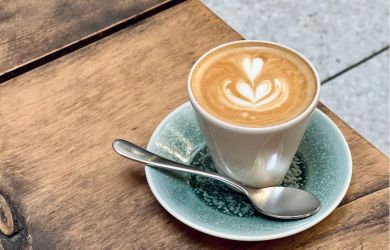
June 24, 2010
Post-Impressionism
A wide-ranging portmanteau show unpacks its wares at the NACT
By Metropolis
Originally published on metropolis.co.jp on June 2010

Vincent van Gogh, Portrait of the Artist, 1887, oil on canvas, 44.1 x 35.1cm - ©RMN (Musée d’Orsay) / Hervé Lewandowski / distributed by AMF

Henri de Toulouse-Lautrec, The Clown Cha-U-Kao, 1895, oil on board, 64 x 49cm - ©RMN (Musée d’Orsay) / Hervé Lewandowski / distributed by AMF
Taken literally, “Post-Impression” is something of a catchall term for almost any kind of art that followed the heyday of Impressionism in the late 19th century. This gives the curators at the National Art Center, Tokyo plenty of leeway for their new show. And with the Musée d’Orsay in a generous mood, there’s much for the standard art lover to enjoy—big names include Van Gogh, Gauguin, Cezanne and Toulouse-Lautrec.
But the term Post-Impressionism also has a more intriguing significance. This is derived from the incredibly high esteem accorded to Impressionism itself. Along with the high point of the Italian Renaissance, the movement is typically seen as one of the few great peaks of artistic achievement. To place the suffix “Post-” in front of it, therefore, unwittingly invokes issues of slump and decline.
But starting at the top, the exhibition’s opening section, “Late Impressionism around 1886,” presents three excellent Monets, including the sublime London, Parliament: Sun Through the Fog (1904). Although you would never see some of the colors Monet uses glittering on the Thames or burning through the gray clouds enveloping Victoria Tower, this is a painting that has the unmistakable aura of London, showing that the best Impressionism, by moving away from conventional realism, actually succeeded in more effectively capturing reality.
From such a peak, the decline is stark, as section two focuses on the pointless novelty of pointillism. This style of art, pioneered by Georges Seurat, took the Impressionist idea of relatively unmixed colors to extremes. Images were depicted using tiny, distinct dots of pure color in what seems like an early attempt at pixelation. Although this created soft, restful images, it did so by weakening lines, killing light and bleeding the images of life. Occasionally, however, it came into its own, as in Belgian artist Georges Lemmen’s Beach at Heist (1891), where the tiny dots deftly capture the texture of sand.
A section devoted to Paul Cezanne follows, suggesting that his style was a development of pointillism, but with patches of parallel brushstrokes instead of dots. This gives paintings like Bathers (ca. 1890) a kind of woven look. The exhibition’s other sections—“Toulouse-Lautrec,” “Van Gogh and Gauguin,” “The Triumph of Decoration,” etc.—help create the impression that rather than a single exhibition, this show is in fact a mélange, a number of distinct smaller shows bundled together. Seen in these terms, “Post-Impressionism” can either be considered a curatorial mish-mash or extremely good value: several exhibitions for the price of one!

Henri Rousseau, The Snake Charmer, 1907, oil on canvas, 169 x 189.5cm - ©RMN (Musée d’Orsay) / Hervé Lewandowski / distributed by AMF
But the problem with this approach is that some of the sections attract a lot more attention, while others are merely walk-throughs. After devoting a lot of time and energy to the impressive array of Van Goghs and Gauguins, most visitors may develop something of a blind spot for succeeding displays like “The Nabis,” which focuses on a movement that made a virtue of low-key, esoteric art.

Pierre Puvis de Chavannes, The Poor Fisherman, 1881, oil on canvas, 155.5 x 192.5cm - ©RMN (Musée d’Orsay) / Hervé Lewandowski / distributed by AMF
Although there are some links and continuities between the various sections of the show, any attempt to view the entire exhibition as a continuous narrative is doomed. Nothing emphasizes this more than the small section devoted to Henri Rousseau, a painter too aesthetically odd to fit into any wider scheme.
The two paintings on display here—War (1894) and The Snake Charmer (1907)—not only make a mockery of the idea that Post-Impressionism is a meaningful term, but almost steal the show with their fascinating “psychological realism.” The naively precise way in which Rousseau paints each and every detail seems to reveal the inner workings of his mind, showing the dogged will to comprehend and capture the products of his limited artistic imagination. This is what makes such compelling art. The Snake Charmer in particular, with its quaint subject matter, is magical, and a delightful antithesis to the attempts at Post-Impressionist sophistication elsewhere.
Note: The museum is less crowded on Friday nights, when it remains open until 8pm.
The National Art Center, Tokyo
Until Aug 16, free (MS and under)/¥800 (HS)/¥1,200 (univ)/¥1,500 (adult). 7-22-2 Roppongi, Minato-ku. Tel: 03-6812-9900. Open Wed-Mon 10am-6pm, closed Tue. Nearest stn: Roppongi, exit 4. www.nact.jp







